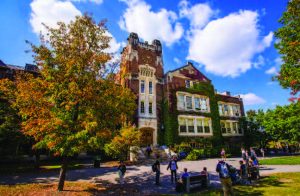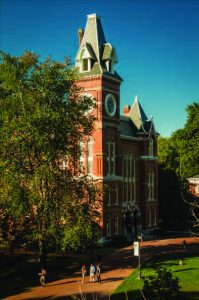There’s a hidden gem waiting to be discovered by your college-bound teen

Photo by Mark Olencki
One of my most important tasks as an independent educational consultant is the development of a list of colleges appropriate to each student who walks into my office. I must consider the qualifications of a student—grades, the rigor of high school classes, test scores, activities, unique gifts and attributes as a candidate, and so on. I also think about the student’s preferences in colleges—big or small, East or West or North or South, highly pressurized or more laid back, religious or not. A consultant has to be sensitive to other factors, such as cost or special services. In the end, people in my profession seek that sometimes-elusive, but always crucial, love match.
Some list builders look to familiar, name-recognition colleges and universities. In some cases, this is done to the detriment of schools that—while not enjoying mainstream popularity—truly provide a transformative learning environment. There is no set list of these hidden gems; that depends on a combination of a student’s profile and a consultant’s knowledge of colleges. Making that list and checking it twice, well, even for a professional, it’s a labor-intensive process.
Let’s look at a hypothetical student, and how I go about creating a short list of hidden-gem schools. Your own college-bound teen may share many of these qualities or just a few. The important thing is to gain insight into the factors that contribute to a solid group of possibilities—so keep your eyes and minds open! I would like to credit my colleague, Dr. Steve Antonoff, for the case study summarized below—a junior whom we’ll call Emma—which we utilize in our UC Irvine online class, Principles of Educational Consulting:
Emma works hard for her grades at a moderately competitive public high school in a suburb of a large metropolitan city. She’s an interesting person. She has studied Chinese on her own, likes drafting, is into martial arts, and enjoys outdoor life. She clearly prefers cooperation to competition. She’s a low-key, introspective type. Emma wants to find the right match and wants something off the beaten path. Emma wants a small-to-medium-sized school. She prefers personal interaction between student and teacher. Very self-aware, she knows that she needs to be involved to be interested.
Emma’s activities include Cross-Country—all 4 years of high school—Track, Key Club, Stagecraft (about two shows per year), Theatre Company Club, Student Council officer in senior year, NHS, Aikido, African Drumming, Film Production (and viewing), and Snowboarding.
Emma likes arts and is considering a career in architecture or engineering, but wants a broad liberal arts education as an undergraduate. She seeks a balance between academic and social life and a school that’s not cutthroat. She does not want Greek life or for the college culture to be spectator-sports focused. Emma expects the people at her college to be creative, energetic (yet laid-back), scholarly, and supportive.
Emma has said, “The fit of the college is more important than the name/prestige. In fact, the prestige of the college means nothing to me.” She also wants to avoid schools with set cliques and social groups. Ideally, she would like to be close to mountains and/or an ocean. Access to a major city would be nice. She does not want abysmal weather. Her GPA is a 3.8 (approximate unweighted), her class rank is 38/475 and on her first ACT, she scored a 29. By her senior year, she’ll have several AP classes and most of her high school transcript contains accelerated courses. She has written her essay on her interest in Chinese language and culture.
Wow. Where do you start? There are approximately 4,000 four-year undergraduate colleges in the U.S., so the choices are abundant. In Emma’s case, I have left geography open; most students I see in my office do have geographic limitations—placed on them by themselves or parents—as to how far they may travel to attend college. Some (and in many years, most) have financial restrictions, as well. For our purposes, however, we’ll set cost aside. Here are five under-the-radar/ahead-of-the-curve schools that I believe would be a nice fit:

Photo by Keith Walters
SUNY Geneseo • New York 5
A little gem hidden in the Finger Lakes region of western
New York state, SUNY Geneseo is still not on many applicants’ radar. At a mere $10,000 per year for out-of-state students, Emma’s parents will be rubbing their eyes in disbelief. Complete with a quaint Main Street walkable from campus, SUNY Geneseo boasts a reputation as the “honors college” of the SUNY system (without the zero-sum game of most selective institutions). Leadership and a small, liberal-arts size and feel—with access to the great outdoors—makes this a very nice find for Emma.

Photo by Mark Olencki
Wofford College • South Carolina 5
Wofford is the little darling of many Southern in-the-know families, but doesn’t seem to hold the same reputation in the North…yet. A small community of 1,500 undergraduates may be the reason. Up North, we drive by a dozen liberal arts colleges during our morning commute alone, but in South Carolina, Wofford resembles a Northern liberal arts college. Southerners seem to like the slightly conservative feel of the campus, the lack of cliques, and the location of Spartanburg, an up-and-coming growing community amongst young professionals. There is much to do and see, and with access to major airports—and other recognizable universities in close proximity—Emma should at least attend an information session to see if she can envision herself here for four years. Don’t expect a bargain price-wise, as is the case with some other Southern institutions. A solid $50,000 all-told is what you’ll pay per year for this excellent education.
 Lewis & Clark College • Oregon
Lewis & Clark College • Oregon
Lewis and Clark in Portland is right up Emma’s alley. While the average class size is 19, there are also several noted graduate-school programs that add to the academic mix. L&C self-identifies as seeking “independently minded scholars who thrive with a challenge.” This fits Emma’s personality and desire to be fully engaged in her learning. In these times of great uncertainty with college admissions, a student applying from another geographic location entirely could be an attractive attribute for a school that is more regionally recognized in the Northwest.

Photo by Tom England
Oxford College • Georgia 4
Oxford ranks as a hidden gem for a very hot reason: if admitted, the 950 students get to join Emory University in Atlanta as juniors, or remain on the Oxford campus (25 miles from Emory) for the remainder of their undergraduate studies. Small liberal arts—with a big university awaiting should a student choose—offers something unique in the college landscape. Emma would thrive in the small Oxford environment initially and be able to opt for something bigger should she desire more diversity or intellectual stimulation as her major and career aspirations develop. Drive due North from Atlanta and in two hours, Emma could be hiking the Appalachian trail or whitewater rafting in Rabun Gap, an outdoor enthusiast’s wonderland.
 Georgian Court University • New Jersey 5
Georgian Court University • New Jersey 5
Here’s something new for the college-savvy prospective student: GCU just went coeducational last fall, previously remaining all-female since its founding in 1908. The historic campus was formerly owned by the late George Jay Gould, whose father, a rail road entrepreneur, was once the ninth richest man in America! Complete with a Japanese garden, a “real” tennis court (there are less than a dozen of these historic courts in the world!) and an arboretum, this gorgeous campus is enjoyed by approximately 1600 undergraduates and under 1000 graduate students. A Catholic college in the Mercy tradition ensures a quality education that differentiates itself with intentional values-infused courses taught by extremely dedicated faculty. Minutes from the beach, Emma will enjoy weekends at the Jersey Shore. EDGE
Editor’s Note: Erin Avery founded Avery Educational Resources (@averyeducation) in 2003. She is a Certified Educational Planner who specializes in college and boarding school admissions. Avery holds degrees from the Peddie School, Boston College, Oxford University, Yale University and is currently completing a doctorate at Drew University in Madison. She notes that New Jersey is practically bursting with hidden gems, but in the spirit of variety, only one was included in this story. In addition to the in-state school mentioned, the author also identified Drew University, Bloomfield College, Felician College, Saint Peter’s University and the New Jersey Institute of Technology as potentially intriguing fits.
HOT FUN IN THE SUMMER TIME
Many families ask if campus visits are a waste of time if done during the summer. With the increase in student commitments, both athletic and extra-curricular—combined with the desire not to miss school days and risk falling behind—school breaks simply do not allow for enough time to conduct comprehensive campus visits. Seeing campuses while students are present is preferred, however summer time should also be used to explore. If it is truly a good match, following up with college social media connections and admission representatives can help to clarify any questions about student culture and fit.





